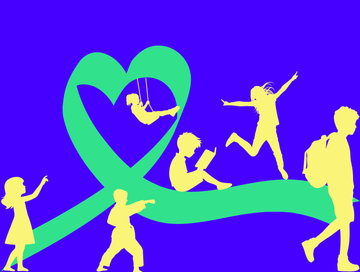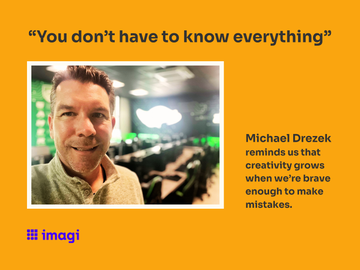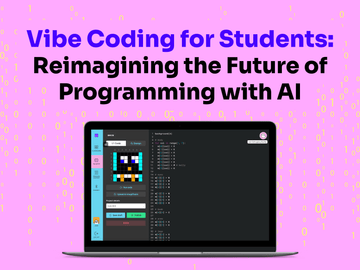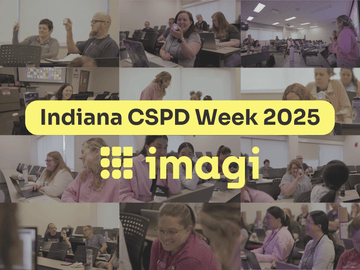
In 1949, Mental Health America founded mental health month and has since led efforts every May to promote mental wellness nationwide. As the month draws to an end, it’s important to reflect on the numerous ways we can support students’ mental well-being, both in and out of the classroom.
In a world that is becoming increasingly digital, it can be argued that coding has become more than a mere technical skill: it’s a mindset. It’s often stressed that when students learn to code and gain computational thinking skills, it prepares them for a tech and AI driven future.
However, we may be overlooking a significant benefit: the positive effects on one’s mental well-being. Coding and computational thinking can help students build resilience, promote creativity and self-expression as well as foster a sense of connection and belonging, all of which can positively contribute to better mental health and well-being.
Building Resilience Through Problem-Solving
Life will inevitably present its challenges. Some big, some small; some expected and more often than not, unexpected. The ability to bounce back and find equilibrium again is a critical life skill for all. Building this resilience is especially important during the formative years of childhood and adolescence. Furthermore, at its core, coding is about solving problems. Previous research conducted by Massachusetts Institute of Technology (MIT) found that coding allows the brain to practice difficult cognitive problem-solving tasks, which enhances overall problem-solving abilities.
Additionally, many coders can attest that a single misplaced comma or misspelled word may prevent a program from running. These errors are often hard to detect due to coding's narrow margin for error. Although coding tasks like writing code or debugging can be challenging, they also provide valuable opportunities to cultivate persistence and adaptability, helping students view failure as a chance to learn, rather than a setback. Thus, encouraging a growth mindset coupled with resilience and tenacity.
Promoting Creativity and Self-Expression
Coding isn’t just logical, it’s also deeply creative. From designing personalized apps to creating digital art or interactive stories, coding allows young people to bring their ideas to life. For many learners, including girls, nonbinary youths, and other students from underrepresented or marginalized backgrounds, creative coding platforms like imagi offers a powerful outlet for self-expression in a tech space that can often be perceived as rigid, exclusive, or unwelcoming. Creating something original and unique exercises ingenuity, and instills pride and ownership.
For example, one educator shared how her student used our imagiEdu platform to code an animated whale design inspired by the book Song for a Whale by Lynne Kelly, a story about a 12-year-old deaf girl who sets out to communicate with a whale that cannot connect with its own species. The book sheds light on the deaf community and explores themes of belonging, connection, and finding one’s voice. The student presented her design during her school’s Literacy Night, expressing her love for storytelling, while also highlighting inclusivity and representation for disabled communities. Hence, this creative freedom not only empowers students to share their identities, passions, and interests through coding and tech, but it can also foster a positive self-image that supports one’s emotional well-being.
Creating Communities And Fostering Connection & Belonging
Learning to code can be a communal experience. For example, students can brainstorm coding or tech solutions, join coding camps, clubs or communities, or participate in hackathons and other tech-related competitions. These experiences can expand students’ perspective and teach them how to collaborate innovatively and effectively with peers from different backgrounds and experience levels. This in turn can foster a strong sense of connection and belonging. This is especially important for children and youth who may feel isolated or uncertain about where they fit in as they grow and explore their identities. Being part of an inclusive and supportive tech community can provide a sense of purpose, boost confidence, and positively impact mental well-being.
Moreover, at imagi, we’ve seen firsthand the powerful role coding can play in helping youths build community and forge meaningful connections, especially through our free imagi app, available exclusively on iOS devices. Within the app’s growing ‘Explore’ Community tab students are discovering different spaces to express their creativity and connect with others who share their interests. One great example is the imagi Coding Club thread, created by user heart0407. In this thread, members from around the world come together to share all things coding, participate in weekly polls, and bond over their passion for all things tech. These interactions champion continuous learning and help create communities and friendships. All of which are essential for nurturing positivity, fostering meaningful relationships, and supporting the mental well-being of students and youths.
As Mental Health Awareness Month draws to an end, let’s recognize the role coding, tech, and computational thinking can play in supporting students’ mental well-being. Technology does more than merely equipping students with technical skills, it empowers them to face life’s challenges with perseverance and creativity, alongside supportive communities. By being mindful of how students use and engage with tech and AI, we can foster supportive and uplifting environments that nurture their growth, resilience, emotional and social well-being, and overall mental health.




